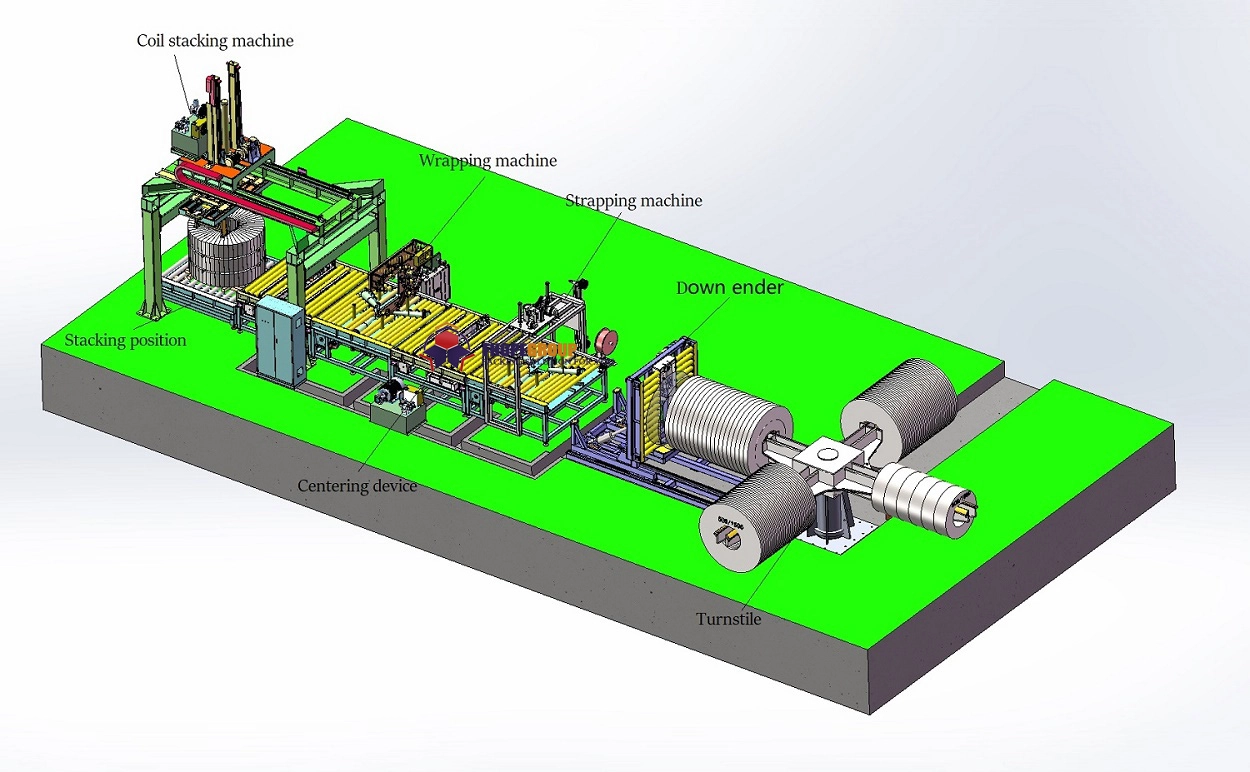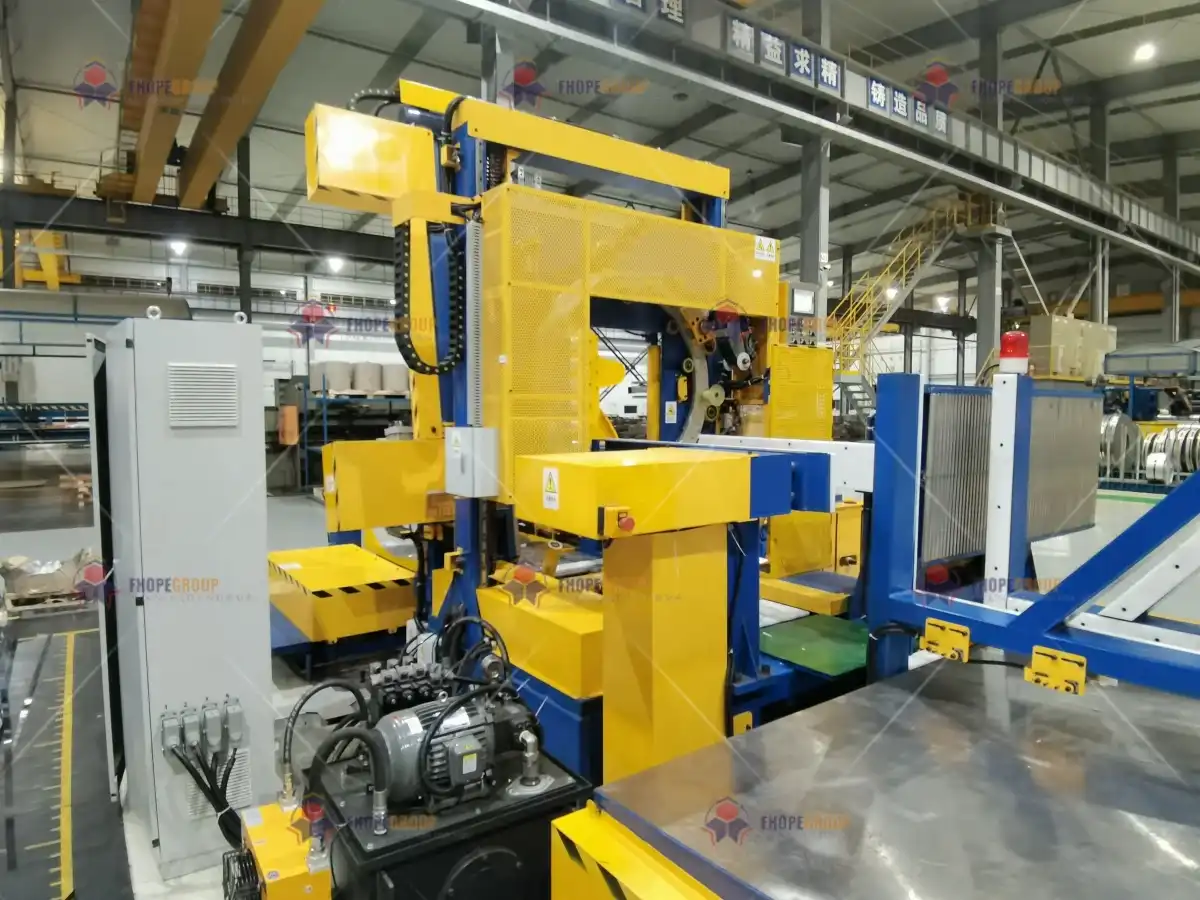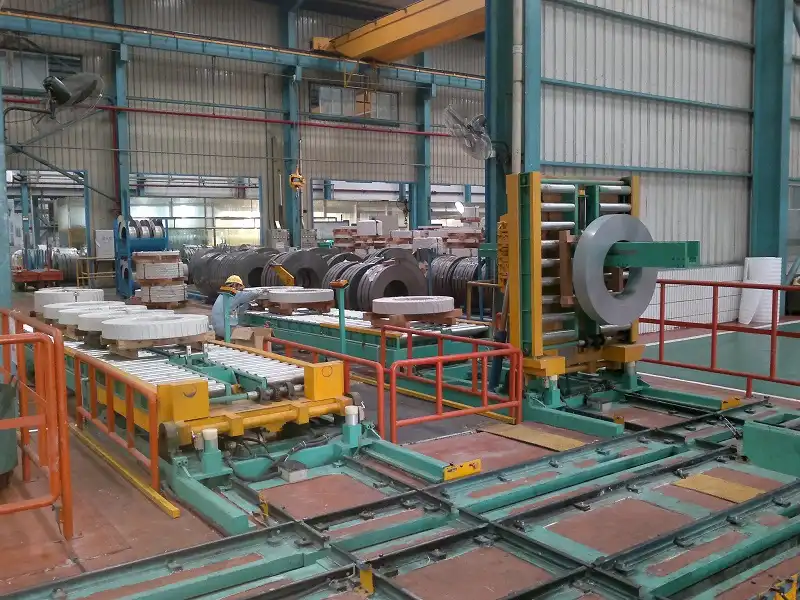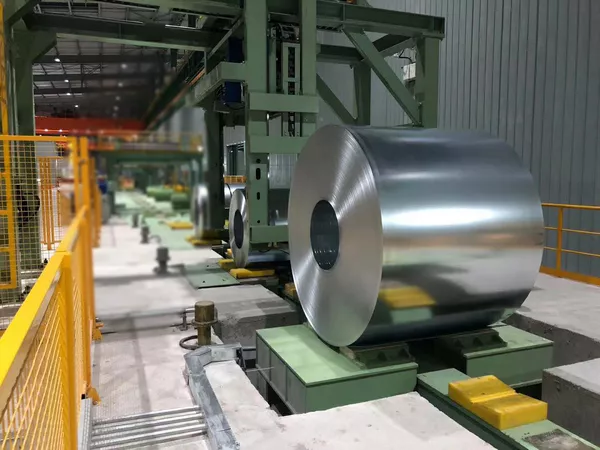As an engineer who has spent his entire career in the coil packing industry, I've seen a lot. I started on the factory floor, learned every nut and bolt, and eventually built my own company, SHJLPACK. This journey taught me one critical lesson: the final step of your production, the packing line, can either protect your profits or destroy them. Many steel mill owners I talk to invest heavily in producing perfect steel coils. But they often overlook the final 100 feet of their production line, where that perfection is put at risk. A slow, unreliable, or inefficient packing line becomes a major bottleneck, especially when you're trying to meet the high-volume, high-quality demands of a market like the U.S. This can lead to delayed shipments, damaged products, customer complaints, and a constant feeling of leaving money on the table. The solution is not just a new machine, but a new way of thinking. It’s about building a total solution that ensures your high-quality coils are protected, your throughput matches your production, and your costs are under control.
Yes, your coil packing line can be equipped to handle demanding U.S. volume and quality standards, but it requires a strategic approach. It must be engineered for high, consistent throughput, superior wrapping quality to prevent damage, and near-perfect uptime. This is achieved by focusing on intelligent automation, robust mechanical design, and seamless integration with your plant's overall logistics and data systems. An honest evaluation of these areas will determine if your current line is a competitive asset or a critical liability.

I have walked through countless mills and spoken with owners like you. They are brilliant at making steel, but the complexities of packaging can be a blind spot. They face the same challenges: aging equipment, rising costs, and the constant pressure to be more efficient. So, how can you be certain your packing line is ready for the big leagues? Let's break it down into the key questions I always ask. I want to share my knowledge, learned through years of trial and error, to help you make the right decisions for your business.
Is Your Throughput High Enough for Peak U.S. Market Cycles?
You have a great quarter. Orders are flooding in from the U.S., and your mill is running at full tilt. This is the moment you've been working for. But then, you see coils piling up before the packing station. Your shipping department is waiting. Your expensive production equipment is being slowed down by the final step in the process. This is a common problem. The packing line, often an afterthought, becomes the single biggest bottleneck in the entire operation. This inefficiency directly costs you money. You miss out on the peak demand, fail to capitalize on high prices, and may even face penalties for late shipments.
To meet the demands of peak U.S. market cycles, your packing line's throughput needs to be faster than your production line's output. A well-designed, automated line should be able to process a standard steel coil—including weighing, strapping, wrapping, and labeling—in under 90 seconds. This speed ensures that packaging never becomes the reason your shipments are delayed.

A Deeper Look at Speed and Efficiency
Throughput is not just about the rated speed of the wrapping machine itself. It’s about the entire workflow, from the moment a coil leaves the slitter to the moment it’s ready for the warehouse. I have seen many factories buy a "fast" wrapper, only to find their overall throughput hasn't improved. This is because the real delays happen between the steps. A truly high-throughput line is a synchronized system.
Breaking Down the Packing Cycle
To understand your true throughput, you must time every single action. How long does it take for the coil to be loaded onto the packing line? Is the coil centering process manual or automatic? How long does the wrapping take? Strapping? Weighing? Labeling? Each manual intervention adds variability and time. For example, an operator manually feeding a strap through a coil can take 30-60 seconds. An automatic strapper does it in 10. These seconds add up over hundreds of coils per day. An efficient line minimizes the "dead time" where the coil is waiting for the next action. This is achieved through well-placed sensors, fast conveyors, and machines that communicate with each other.
The Critical Role of Automation
Automation is the key to unlocking consistent, high throughput. When I design a line, I focus on automating the repetitive, time-consuming tasks.
- Automatic Coil Loading and Centering: This ensures the coil is perfectly positioned for wrapping every time, eliminating manual adjustments.
- Automatic Strapping: Integrated strapping machines, both radial and circumferential, secure the coil without operator intervention.
- Automatic Wrapping and Cutting: The machine should automatically start the wrap, apply the film, and then cut and clamp it at the end of the cycle.
- Integrated Weighing and Labeling: A scale integrated into the conveyor and an automatic label applicator save crucial minutes and prevent human error.
This level of automation directly supports goals like reaching 95% capacity utilization. Your mill can't run at 95% if the packing line only runs at 70%.
| Task | Semi-Automatic Line (Time in Seconds) | Fully Automatic Line (Time in Seconds) | Impact |
|---|---|---|---|
| Coil Loading & Centering | 45-75 | 15 | Reduced manual effort, improved consistency |
| Strapping (2 straps) | 60-90 | 20 | Massive time savings, better safety |
| Wrapping Cycle | 60 | 45 | Faster cycle with optimized programming |
| Film Cut & Clamp | 15 | 5 | Eliminates a common manual failure point |
| Weighing & Labeling | 60 | 10 | Reduced errors, faster data entry |
| Total Cycle Time | 240-300 | 95 | > 60% reduction in packing time per coil |
Does Your Wrapping Quality Prevent Costly Damage and Rejections?
You have invested millions in technology and training to produce steel coils with perfect surface quality and exact specifications. Your team takes pride in this. But all that work can be undone during the journey from your mill to your customer in the U.S. A coil that arrives with rust spots from moisture, edge damage from poor handling, or scratches from a loose wrap is a rejected coil. This is more than just a financial loss on one shipment. It creates a cascade of problems: expensive return freight, administrative headaches processing claims, and most importantly, damage to your reputation as a quality supplier.
To prevent rejections, your wrapping must create a secure, waterproof, and puncture-resistant cocoon around the coil. This is achieved not by using more film, but by using it smarter. A modern packing machine with a powered pre-stretch system and precise overlap control ensures a tight, consistent wrap that provides maximum protection with minimum material.

A Deeper Look at Protective Packaging
From my experience, about 80% of transit damage to coils is related to moisture or physical impact. Both can be prevented with the right wrapping technique and materials. It's a science, and every detail matters. The goal is to achieve what I call "total load containment."
The Pillars of a Perfect Wrap
Three elements must be perfectly controlled to guarantee protection:
- Material Selection: The first layer against the coil should often be VCI (Vapor Corrosion Inhibitor) paper or film. This material releases a harmless vapor that creates a protective barrier on the steel's surface, actively preventing rust. The outer layers should be a high-quality stretch film with good puncture resistance. The thickness and grade of the film must match the weight and edge sharpness of your coils.
- Overlap Control: The amount each layer of film overlaps the previous one is critical. For steel coils, I recommend a minimum of 50% overlap. This creates a double layer of film across the entire surface, making it much more difficult for water to find a path to the steel. On modern machines, this is a simple setting in the HMI. On older machines, it’s often inconsistent and depends on the operator.
- Tension and Pre-Stretch: This is the most important factor. A loose wrap offers almost no protection. The film must be stretched and applied tightly. A powered pre-stretch carriage is essential here. It uses two rollers rotating at different speeds to stretch the film by 200-300% before it gets to the coil. This makes the film stronger and ensures it clings tightly, securing the coil and preventing any movement.
The Real Cost of a Single Damaged Coil
Let's imagine a single coil worth $2,000 is rejected by a U.S. customer. The cost isn't just $2,000. You also have to consider:
- Outbound Freight: $1,000 (lost)
- Return Freight: $1,000 (new cost)
- Administrative Time: Hours spent on calls, emails, and paperwork.
- Reputation: The customer may be hesitant to place their next big order with you.
A single failure can cost you double the product's value. Investing in a packing line that eliminates these failures has one of the fastest ROIs in the entire mill. It directly supports the goal of reducing overall operating costs.
| Wrapping Defect | Common Cause | Consequence | Modern Solution |
|---|---|---|---|
| Loose Wrap | No pre-stretch or low tension | Film shifts, allows water ingress, offers no support | Powered pre-stretch carriage (250%+) |
| Gaps in Coverage | Incorrect overlap setting | Exposed areas are vulnerable to rust and scratches | PLC-controlled overlap, set to 50% minimum |
| Film Tears/Punctures | Sharp coil edges, low-quality film | A small hole allows moisture to penetrate the entire coil | Proper edge protection, high-puncture film |
| Water Trapping | Wrapping a wet coil, poor final seal | "Greenhouse effect" inside the wrap, causing rust | Air blowers before wrapping, secure heat seal |
Can Your Aging Equipment Maintain the Uptime U.S. Contracts Demand?
Your 15-year-old packing machine has been a reliable part of your operation for years. Your maintenance team knows its quirks, and you’ve managed to keep it running. But lately, the small problems are becoming more frequent. A sensor fails. A bearing starts making noise. Finding spare parts for the outdated PLC feels like a treasure hunt. This is a risky situation. When you are supplying major U.S. clients, their production lines depend on your deliveries. A two-day shutdown on your packing line doesn’t just mean a late shipment; it can mean shutting down your customer's factory. That’s how you lose a contract.
No, aging equipment with an increasing failure rate cannot reliably maintain the 95%+ uptime required by demanding U.S. contracts. Older machines lack the durability of modern components and, more importantly, the ability for predictive maintenance. To guarantee reliability, you need a system built with robust, readily available parts and equipped with sensors that can forecast problems before they cause a shutdown.

A Deeper Look at Reliability and Maintenance
When I was an employee at a packing machine factory, the biggest source of stress was always emergency repairs on old equipment. It taught me that waiting for something to break is the most expensive maintenance strategy. For a CEO or plant owner, unexpected downtime is a profit killer. It disrupts schedules, wastes labor, and can lead to huge costs in expedited freight to fix a delayed order. A modern approach to equipment is not about avoiding repairs, but about eliminating unplanned repairs.
The Shift from Reactive to Predictive Maintenance
This is a critical mindset change that leaders like you are driving.
- Reactive Maintenance (The Old Way): The machine breaks. Production stops. You call maintenance. They diagnose the problem. You hope they have the part. If not, you wait for it to be shipped. The line is down the entire time.
- Predictive Maintenance (The Modern Way): This is a key part of the digital transformation you are aiming for. Sensors on the machine monitor key components. For example, a vibration sensor on the main ring bearing can detect tiny changes that indicate wear, long before the bearing fails. A temperature sensor on a motor can signal an overload issue. This data is fed to your MES or control platform. Your system can then flag that "Bearing A has a 90% chance of failure in the next 30 days." You can then schedule the replacement during planned downtime. There is no surprise, and no lost production.
Key Failure Points in Aging Wrappers
After inspecting hundreds of machines, I can tell you where they almost always fail first. When evaluating your own equipment, pay close attention to these areas:
- The Main Ring and Support Rollers: This is the heart of the machine. Worn bearings or rollers cause vibration, leading to poor wrap quality and eventual catastrophic failure.
- The PLC and HMI: A PLC from 15 years ago is obsolete. If it fails, you cannot buy a new one. You will have to re-engineer the entire control system, which could take weeks. A modern line uses standard, off-the-shelf PLCs from brands like Siemens or Allen-Bradley.
- Drive Systems: Older DC motors and simple starters are inefficient and prone to failure. Modern AC motors with VFDs are more reliable, more efficient, and offer much better control.
- Cutter and Clamp Assembly: This is a high-cycle mechanical part. After millions of wraps, springs, blades, and pneumatic cylinders wear out. A failure here stops the entire line.
| Component | Signs of Aging / Risk | Impact of Failure | Modern Solution / Mitigation |
|---|---|---|---|
| PLC/Control System | Obsolete model, no spare parts | Weeks of downtime for a complete system retrofit | Modern Siemens/Allen-Bradley PLC |
| Main Ring Bearing | Increased noise, vibration, metal shavings | Catastrophic failure, line stoppage for days | Vibration sensors for predictive monitoring |
| Drive Motors | Overheating, inconsistent speed | Inconsistent wrap quality, burnout, fire risk | High-efficiency AC motors with VFDs |
| Sensors/Switches | Intermittent faults, physical wear | Random stops, incorrect machine positioning | Non-contact proximity sensors, laser sensors |
Is Your Packing Line Optimized to Control Rising Material and Energy Costs?
As a steel mill owner, you are constantly fighting a battle against costs. The price of electricity, fuel, and raw materials is always fluctuating, usually upwards. You have likely implemented major projects, like using furnace gas for power generation, to tackle these costs on a large scale. But costs can also be controlled at the individual machine level. Your coil packing line consumes two key resources: packing material (stretch film, paper, straps) and electricity. An old, inefficient line wastes both on every single coil it wraps, slowly eroding your profit margin day after day.
Your packing line is optimized for cost control only if it actively minimizes resource consumption. This means it must have a powered pre-stretch system that achieves at least a 250% film stretch, which can cut your film usage by more than half. It should also use variable frequency drives (VFDs) and high-efficiency motors, which can reduce its electricity consumption by 20-30% compared to older designs.

A Deeper Look at Material and Energy Savings
When I founded SHJLPACK, my goal was to be a total solution provider. That means I don't just sell a machine; I provide a way for my clients to be more profitable. Reducing operating costs at the packing stage is one of the easiest wins a steel mill can get. The technology is proven, and the payback period is often surprisingly short. These savings directly contribute to your goal of an 8% reduction in overall operating costs.
The Financial Magic of Pre-Stretch
This is the single most important technology for reducing material costs. Let me explain it simply. Without pre-stretch, the film is just pulled around the coil. It's loose and you use a lot of it. A powered pre-stretch carriage is a small device on the wrapper with two rollers. The second roller spins 2.5 to 3 times faster than the first. The stretch film passes through these rollers and is stretched before it ever touches the coil.
- The Result: 1 meter of film from the roll becomes 3 meters of film applied to your coil. You immediately use 66% less film.
- The Bonus: This stretching realigns the molecules in the film, making it significantly stronger and tougher. So, you use less film, but you get a stronger, more secure wrap.
If your mill spends $100,000 per year on stretch film, a machine with 250% pre-stretch can reduce that cost to under $40,000. The savings are direct, immediate, and continuous.
Smart Energy Consumption
Your challenge with volatile electricity prices means every kilowatt-hour counts. An old packing line with motors that run at full speed all the time is an energy hog. A modern, energy-efficient design incorporates several key features:
- Variable Frequency Drives (VFDs): Instead of running at 100% speed or 0%, a VFD allows a motor to run at the exact speed needed. It allows for soft starts and stops, reducing mechanical stress and massive inrush currents. This can cut the motor's energy use by 20-30%.
- High-Efficiency Motors: Modern motors are simply designed to do more work with less electricity, meeting standards like IE3 or IE4.
- Intelligent Programming: When the line is idle between coils, the programming can put motors and other components into a low-power "sleep" mode, waking them up instantly when the next coil arrives.
| Feature | Traditional Packing Line | Optimized Packing Line | Financial & Operational Impact |
|---|---|---|---|
| Film Usage | No pre-stretch (0%) | Powered Pre-Stretch (250-300%) | ~60% reduction in film cost |
| Wrap Strength | Low & inconsistent | High & consistent | Fewer damage claims, better load security |
| Motor Control | Direct-on-line starters | Variable Frequency Drives (VFDs) | ~25% reduction in energy use, less wear |
| Labor Requirement | High (manual tasks) | Low (fully automated) | Reduced labor cost per ton, improved safety |
Conclusion
Upgrading your coil packing line is not a cost; it's a strategic investment in efficiency, quality, and reliability, securing your competitiveness in the demanding U.S. market.





